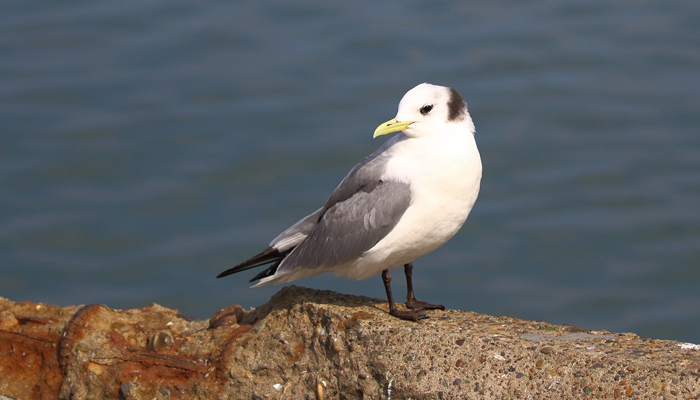
English: Black-legged Kittiwake, Kittiwake
Russian: Моевка, Трехпалая чайка
Mongolian: Гурванхуруут захлай
German: Dreizehenmowe
French: Mouette tridactyle
Japanese: ミツユビカモメ (Mitsuyubi-kamome)
Body length: 37-42 cm.
Wing span: 93-105 cm.
Rarely seen far from sea.
Breeds colonially (at times several tens of thousands of pairs) on steep
sea-cliffs, sometimes on buildings. Common near colonies and fishing ports, or
boats at sea. Foods invertebrates and fish, including waste from commercial
fishing.
Identification: Three
age-groups. A trifle larger than Black-headed, with slight notch in tail and
short legs. Stiff, quick wingbeats and narrow outer wing give less ‘lazy’, more
tern-like flight than other gulls.
- Adult: Small black triangle
on wing-tip; dark grey upperparts shade to whitish before black wing-tip,
adding to distinctiveness of almost three-coloured wing pattern; bill
yellowish; legs dark brown or blackish (rarely red, orange or flesh); head
white in summer, with grey hindneck and crescentic blackish ear-spot in winter.
1st year: Dark ‘W-pattern’ across wings and black tail-band; juvenile and some
1st winters have white head with black ear-spot and black half-collar; otherwise
head as adult winter; ‘W’ often much faded by 1st summer, and bill becomes dull
yellowish with dark marking at tip.
- Juvenile/1st -winter similar
to 1st -year Little Gull but, with practice, recognized by different structure
(Kittiwake is bigger-headed) and flight action. Kittiwake is darker grey above,
has cleaner white rear portion of wing, and lacks Little Gull’s dark cap and
small black patch where under secondaries meet body. 2nd -year: Like adult, but
told at close range by e.g. black fringes on outermost primaries, some black on
bill, or winter head pattern in summer.